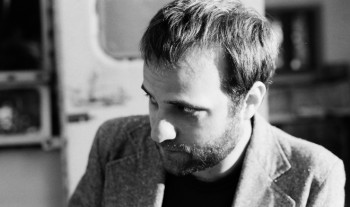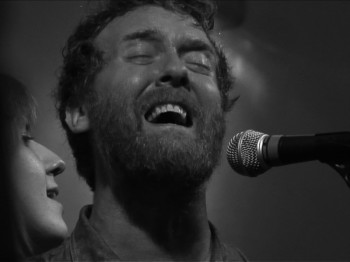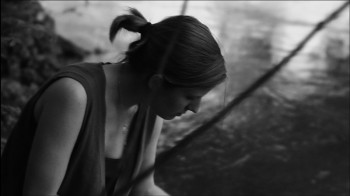 Nick August-Perna is co-director and primary editor for the much celebrated documentary, The Swell Season, which is being presented at 9:15 PM on December 1st at the Art Theatre, located in the heart of 4th Street’s Retro Row. The film follows Glen Hansard and Marketa Irglova as they tour in the US, and Europe.
Nick August-Perna is co-director and primary editor for the much celebrated documentary, The Swell Season, which is being presented at 9:15 PM on December 1st at the Art Theatre, located in the heart of 4th Street’s Retro Row. The film follows Glen Hansard and Marketa Irglova as they tour in the US, and Europe.
Hansard, lead singer for The Frames, and Irglova rose to international fame as the stars of a low budget indie musical, Once, which earned the World Cinema Audience Award for a dramatic film at the 2007 Sundance Film Festival, and an Academy Award for for Best Original Song for the song Falling Slowly.
Nick August-Perna came up in the Graduate film department at NYU, where he connected with co-director Carlo Mirabella-Davis. Prior to making The Swell Season, he’d worked steadily as an editor, and on long form projects for Human Rights Watch and the PBS series, Wide Angle.
I asked him how the project got started.
Nick: Well, its a circuitous story. Carlo was teaching film at the New York Film Academy and, after Glen and Mar had won the Academy award, Glen came to take a week-long course there in making films. He was always very interested in films, Herzog’s Fitzcarraldo for example. So he made a few shorts in Carlo’s class, and he mentioned to Carlo the idea of doing a film about this huge tour he was about to embark on with Marketa and The Swell Season. So the original idea was a kind of upbeat tour film about this wave of momentum after the Oscars and Once.
We all got together, Carlo, Chris, Glen , and myself, and discussed the film in this light initially. When we began filming, it moved slowly but surely in the direction of a more character-driven, personal, and some would say, more moody and shadowy film, possibly uncomfortable to watch at times, at least for Glen and Mar.
Sander: Was it hard for you, emotionally, to stay connected and engaged while things unfolded?
Nick: Yes, especially in the beginning. For us (the filmmakers), the touring life was a new world filled with its own poetry and pace, a strange vocabulary of rock stardom and quiet, passive moments drinking tea in dim dressing rooms. We didn’t know where the story was at first. We had yet to become truly close with Glen and Mar and develop what would become a deeper trust.
Sander: That must have been strange for you, and for them: To sort of jump into another person’s life so completely, and in the midst of travel and stress and art making.
Nick: Yes, it was jumping on a train that was already moving, nestling into a solid car and trying to remain patient, alert, and assertive at the same time. The goal, in the long term, was to become like ghosts that floated around, bearing witness to their secrets.
Sander: Do you feel you were successful in that regard?
Nick: Eventually, we were. I think when we went to europe, met with Glen’s family, met mar’s family and toured the Czech republic, we arrived at the cafe there in Telc, and for that long conversation, Chris was using a 50 mm lens, so we were sitting beside them quietly with our heads down in a way, filming the transpiring beginnings of the end, and we were unnoticed almost completely at that point.
Sander: What was that like for you to witness and document something so fragile and intimate?
Nick: As a filmmaker, it was quietly exhilarating. As a friend to them, it was somber. I guess that, in many ways, sums up what the documentary is about.
Sander: How did you sort through what must have been a huge amount of material to craft the narrative?
 Nick: We had somewhere between 150-200 hours of footage. Much of that footage was shot in the beginning phase of the first tour: Landscapes, passing American towns, this sort of thing. It was a way to not be pointing the camera at Glen and Mar all the time. As time went on the shoot got more focused.
Nick: We had somewhere between 150-200 hours of footage. Much of that footage was shot in the beginning phase of the first tour: Landscapes, passing American towns, this sort of thing. It was a way to not be pointing the camera at Glen and Mar all the time. As time went on the shoot got more focused.
The editing process, as it always is for me personally, was not about wanting there to be a certain narrative from the beginning. In other words, I feel strongly that the best material, the most truthful moments have to drive the editing process and create a cohesive story over time. That’s a process that takes a long time, very simply put, and its about trust in the process, viewing footage over and over again as some things become relevant later that weren’t before.
I think many of the moments in the film, the small moment between them at a dark bar in the 2nd half of the film, it’s almost a whisper between them and you can barely hear it, which is why we subtitled it. After a time, its like your receptors for what is vividly happening on the screen grows more focused and, in a way, you have a kind of heightened awareness of the material. So many small moments like that ended up in the final cut, and provide subtle shifts in mood between them, and help provide an overall arc to what is a subtle story in some ways, and epic in others.
Sander: What was the production set-up?
Nick: There was only ever one camera, and Chris was on it. I was on sound and Carlo was both a floating lighting unit and led many of the interviews.
Chris was really responsible for putting the rig together. We used a Panasonic HVX HD camera with an adapter that allowed us to use cinema lenses. He used prime [non-zoom lenses] lenses for the majority of the shoot. Chris made his monitor black and white, and this affected how he would expose and draw out the luminant black and white tones and contrast.
Sander: With just one camera, there must have been times when things were happening in different places at the same time. How did you decide where to look?
Nick: Well, it’s the benefit of 3 sets of directorial eyes. A lot was communicated between us through taps and nudges.
Sander: Did you ever want for a second unit, another camera to capture stuff going on elsewhere?
Nick: Not really, no. We were committed to avoiding the ‘chase,’ so to speak. We weren’t interested in moving the film in the direction of a more “realityTV” situation where we filmed every moment of their lives. We all felt it important to put restrictions on the shoot. That forced us to focus on what we felt was integral to the ‘truth’ we were after.
Sander: What were the benefits of those restrictions?
Nick: For one, they never found us annoying. We were patient with them, and they with us. I also think personally that, though there are of course periods of more assertive hunting with the camera, there is a lot that is revealed on its own if you spend enough time with people. You don’t need to chase them everywhere to get what your’e looking for. I always watch those Life of Mammals, Planet Earth shows. I love the segments where they describe the making of [these programs] and, in most cases, once you find the snow leopard, you sort of perch in a good spot for many weeks rather than chasing it around everywhere. Strange analogy, I know, but its similar in spirit, I think.
Sander: What influence on the unfolding events do you think the documentation had?
 Nick: Its a great question, and frankly one that has been appropriately asked since the invention of the camera. I don’t think there is an answer, or at least I’d feel a little foolish trying to give one. I do think that there’s no such things as any event unfolding in a vacuum. There are always influences. Which ones are more affecting than others is something I don’t know. I’m sure that having the camera there had an effect in some way, though I do not believe in a negative way at all. At the end of the day, Glen and Mar are strong, healthy, thriving artists and close friends and collaborators.
Nick: Its a great question, and frankly one that has been appropriately asked since the invention of the camera. I don’t think there is an answer, or at least I’d feel a little foolish trying to give one. I do think that there’s no such things as any event unfolding in a vacuum. There are always influences. Which ones are more affecting than others is something I don’t know. I’m sure that having the camera there had an effect in some way, though I do not believe in a negative way at all. At the end of the day, Glen and Mar are strong, healthy, thriving artists and close friends and collaborators.
Sander: The film has been seen in some festivals since it was completed. Can you talk a bit about its reception?
Nick: Overall, the reception has been great. I’m most excited about the variety of people going to see the film. It is really interesting and inspiring. The idea that both fans of Once and the band are going, as well as people who have not heard of them as much.
Its playing in New York, LA, and then Portland Oregon, and Minneapolis and Taipei. Its exciting for us as this is our first feature together.
Sander: Are you concerned at all that this will be a tough film to follow?
Nick: No. I think it was the product of a really great set of circumstances and collaboration. If anything, I’m more excited about making films than ever before, and a continued collaboration with Carlo and Chris.
I just hope people come to the next film we make, which has a good of a chance of being a horror film as a documentary. So I’d ask everyone to keep an open mind.
—
The film’s official website is TheSwellSeasonMovie.com.
To learn more about the Art Theatre’s schedule, visit ArtTheatreLongBeach.com
To learn more about The Swell Season, visit TheSwellSeason.com

